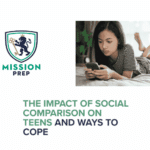Teen Trust Issues: Causes, Signs, and Supportive Approaches

Learning to trust others is a natural part of growing and forming relationships. Yet, not everyone is trustworthy. We need to find a balance between trusting those who care about us and knowing when someone is untrustworthy. This learning process often comes from our early relationships, understanding what trustworthiness looks and feels like, and using this knowledge in our other relationships.
You might notice changes in your child’s trust behaviors during adolescence. Do they trust too easily? Do they tend not to trust people close to them? These changes can be significant in some cases and may have a great impact on your child’s relationship with you, their friends, and even themselves.
This page focuses on teen trust issues and covers the following areas:
- Causes of distrust in adolescents
- Recognizing signs of insecurity in teens
- Mental health problems associated with trust issues
- Therapy for trust issues
- Parental guidance for building trust in teens

Causes of Distrust in Adolescents
Research related to the causes of distrust in adolescents covers a variety of topics. What influences one teen may not affect another under certain circumstances. It’s true that there are biological reasons for distrust in teens as well as environmental factors.
Below, we’ll discuss some of the major causes of distrust in adolescents according to existing research.
Trust and Attachment Theory
Trust and distrust in adolescence are closely tied to attachment theory. According to attachment theory, the earliest relationships in our lives (typically with our parents) are the ones that shape us as we develop.
Different attachment styles are linked to varying levels of trust in teens, with insecure attachment styles being detrimental. When a child develops an insecure attachment style, they begin to believe that the people around them can’t be relied on, relationships in general are fleeting, and trust should be given sparingly.1
Emotion Regulation in Teens
Emotion regulation strategies also influence a teen’s level of trust and distrust. Teens who can better regulate high levels of anger and irritability tend to form more secure relationships and have a solid understanding of trust.
On the other hand, if a child lashes out when they’re angry or misbehaves when they’re irritable, they are more likely to distrust the people around them.2
Adverse Childhood Events
Different distressing events during childhood have the ability to make teens less likely to trust others. For example, children with divorced parents generally show higher levels of distrust, often as a separation rocks the stability a teen feels at home. Instability in their parental relationships can lead to a fear of betrayal by others and a fear of abandonment. In particular, children of divorced parents typically report higher rates of distrust in romantic relationships later in life.3
Trust, Gender, and the Brain
As we mentioned, there are biological reasons for differences in trust and distrust. For example, recent studies showed that women are less trusting than men overall. Brain scans show that men and women use different parts of their brains when deciding whether to trust someone. Men tend to activate areas linked to logical thinking and judging others’ intentions. Meanwhile, women show changes in regions connected with emotional bonding and social connection, especially when there’s a higher chance of being let down.4
This suggests that a teen’s level of trust or distrust may depend on their gender and the brain mechanisms involved in relationship-building.
Now that we’ve considered some of the ways teens develop trust issues, the rest of this article will focus on identifying those issues and getting your child the help they need to form healthy relationships.
Recognizing attachment issues in teens is often crucial to accessing appropriate treatment. This is because attachment issues and fear of abandonment can be closely associated with serious mental health problems.
Recognizing Signs of Insecurity in Teens
Adolescence brings about feelings of insecurity because there is so much changing at that time – body, mind, relationships, goals, expectations. While some teens are able to cope with these feelings effectively, many others struggle.
Look for some of the following signs of insecurity in teens so you can intervene:
1. Social Withdrawal
When a teen begins to withdraw from their family and peers, it may be a sign of a mental health problem. Oftentimes, adolescents who feel insecure will turn to social withdrawal as a way to avoid rejection and judgment. This might involve seeing your child cancel plans with their friends on the weekend, not take phone calls, or leave family dinners to eat alone.
Noticing these signs before they have a significant impact on your child’s well-being is the key to supporting them.5
2. Angry Social Interactions
There are times when insecurity is displayed as anger and irritability. If a child feels like they are expected to achieve things that they don’t believe they are capable of, there is a risk of lashing out at others.
When many of your teen’s social interactions involve arguments, they can leave feeling more angry and irritable. When those feelings become distressing, it reinforces the feelings of insecurity.5
3. Emotional Dependency
Adolescents who rely too much on others for emotional support tend to struggle with feelings of insecurity. If a child thinks they are incapable of doing normal tasks, or fear doing something wrong, they may turn to others for approval. For example, if your child needs to spend all their free time with one best friend and that friend’s behavior plays a large role in how your child thinks and feels, it is a sign of emotional dependence.
Likewise, relying too much on parents is also a problem. If a teen can’t function without constant approval from their parents, they become emotionally dependent. This prevents the teen from developing coping skills and leads to more unhealthy relationships.5
If you notice any of these signs in your child, it’s best to talk to them. Listen to their concerns and try to understand their struggles so that you can find the appropriate help.
Mental Health Problems Associated with Trust Issues
When signs of insecurity in teens worsen, more serious mental health problems can arise. Insecurely attached adolescents are more likely to experience anxiety and depression than their peers.
Major Depressive Disorder (MDD) in Teens
Major depressive disorder (MDD) impacts all areas of a child’s life–from school to friends and family. Other signs of MDD are changes in sleep, increased or decreased appetite, irritability, and interpersonal conflicts.5
Anxiety Disorders and Trust Issues in Adolescence
There are several anxiety disorders associated with trust issues in teens. Specifically, social anxiety disorder (SAD) involves feelings of distress in social situations and avoidance of these situations altogether.
Early intervention for social anxiety can take many forms, including talking to a psychotherapist, participating in a structured program, or working with parents at home to develop coping strategies for distrust.6
Getting the right diagnosis can make a difference in understanding how to address trust issues in teens.
Therapy for Trust Issues
After acknowledging that your child is dealing with a mental health problem, finding the appropriate treatment is the next step. There are many types of therapy for trust issues. We’ll look at a few below.
Cognitive Behavioral Therapy (CBT)
CBT is often the first line of treatment for depression in teens. During therapy, the child is expected to look at negative thought patterns and understand the effect they have on their behavior and emotions. Then, therapists will work with the child to reframe negative thoughts by challenging cognitive distortions (unhelpful ways of thinking not based on facts). While working on changing their thought processes, teens also develop effective skills to change their behavior.7
One helpful tool is looking for evidence that supports negative viewpoints. For instance, if a teen is struggling with trusting their friends, a therapist might prompt them to list the objective facts that support the feeling of distrust. After this, the teen will present the evidence that their belief is not true and compare the two sides of the argument to make a more rational decision about relationships. Other coping strategies for distrust are incorporated in the CBT curriculum as well.7
Dialectical Behavior Therapy (DBT)
Another form of therapy that is helpful for teens struggling with depression and anxiety is DBT. This type of therapy combines individual sessions with skills groups for adolescents and their parents to work on emotion regulation, distress tolerance, mindfulness, and interpersonal effectiveness. DBT skills are designed to be easy to understand and practical for a variety of situations.8
For example, techniques for emotion regulation in teens include acting opposite to the distressing emotions, checking the facts for a stressful situation, and reducing vulnerability factors when making important decisions. Focusing on taking care of themselves physically and mentally, while also challenging problem behaviors, takes time and teens taking part in DBT usually spend at least three hours on therapy each week.8
When working on promoting healthy relationships, the interpersonal effectiveness module of DBT has proven effective. This part of the program teaches communication skills that allow teens to ask for what they want or need in a situation, while also respecting others’ boundaries and reacting appropriately during conflicts.8
There are, of course, other forms of therapy that can be used for supporting confidence in relationships and managing fear of betrayal or abandonment. Explore as many options as you need to in order to find the right fit for your child.
Parental Guidance for Building Trust in Teens
Parents play a critical role in promoting healthy relationships in teens. Modeling positive behaviors in the home is one of the simplest and most effective ways to encourage your child to be more trusting. By communicating clearly with your partner and child, expressing your emotions in healthy ways, and showing respect for others, you can help your child realize that people are generally trustworthy.
Additionally, participating in CBT and DBT sessions with your teen is encouraged to support their confidence in relationships. CBT incorporates family therapy sessions to educate parents on the skills their child is learning, so they know what to look for in terms of progress or setbacks. DBT skills groups with families also get parents involved in learning the skills and practicing them in a safe, therapeutic environment, so your teen gets more comfortable.7,8
Even though navigating all the treatment options for building trust in teens can be daunting, you can feel good about the fact that there is an abundance of resources for parents and teens.

Mission Prep: Promoting Mental Health Awareness in Adolescents
At Mission Prep, we want to make it easier for you to access the right mental health treatment for your child. We have a variety of options available, including outpatient therapy and residential mental health treatment. Our programs integrate CBT and DBT, among other psychotherapy options, to address mental health problems.
If you notice your child struggling with their mental health, reach out to Mission Prep today. Our team can answer your questions, provide advice, and clinical recommendations to get your child back to healthy habits
References
- Weems, C. F., Berman, S. L., Silverman, W. K., & Rodriguez, E. T. (2002). The relation between anxiety sensitivity and attachment style in adolescence and early adulthood. Journal of Psychopathology and Behavioral Assessment, 24(3), 159-168.
- Krabbendam, L., Sijtsma, H., Crone, E. A., & van Buuren, M. (2024). Trust in adolescence: Development, mechanisms and future directions. Developmental Cognitive Neuroscience, 69, 101426.
- Lewis, M. (2013). Trust issues among children of divorce.
- Wu, Y., Hall, A. S., Siehl, S., Grafman, J., & Krueger, F. (2020). Neural signatures of gender differences in interpersonal trust. Frontiers in human neuroscience, 14, 225.
- Allen, J. P., Insabella, G., Porter, M. R., Smith, F. D., Land, D., & Phillips, N. (2006). A social-interactional model of the development of depressive symptoms in adolescence. Journal of consulting and clinical psychology, 74(1), 55.
- Davila, J., La Greca, A. M., Starr, L. R., & Landoll, R. R. (2010). Anxiety disorders in adolescence.
- Spirito, A., Esposito-Smythers, C., Wolff, J., & Uhl, K. (2011). Cognitive-behavioral therapy for adolescent depression and suicidality. Child and Adolescent Psychiatric Clinics, 20(2), 191-204.
- Harvey, L. J., White, F. A., Hunt, C., & Abbott, M. (2023). Investigating the efficacy of a Dialectical behaviour therapy-based universal intervention on adolescent social and emotional well-being outcomes. Behaviour Research and Therapy, 169, 104408.



















